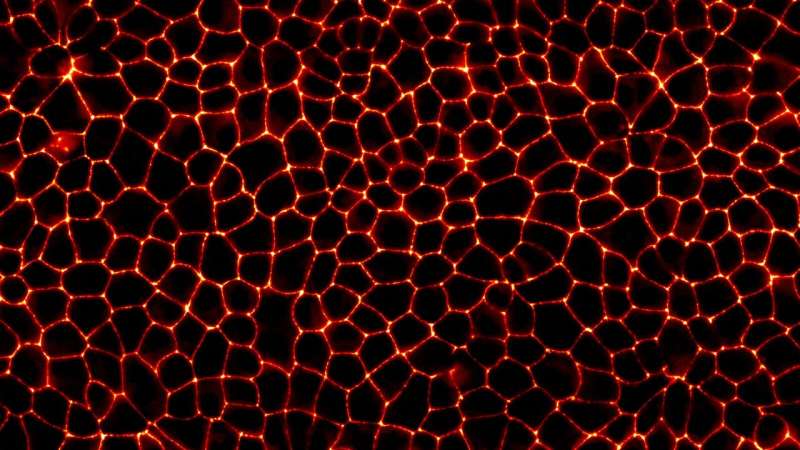
Tight connections between cells, made visible with fluorescence microscopy. Image credit: Honigmann Lab
Our bodies and organs are shielded from the external environment by tissue barriers such as the skin. These barriers must be tightly sealed to prevent unwanted substances from entering. This sealing is achieved by structures called tight junctions. However, how these tight junctions are formed has long been a mystery.
Now an interdisciplinary team of researchers led by Prof. Alf Honigmann at the Biotechnology Center (BIOTEC) of TU Dresden has discovered that the proteins responsible for these seals form a liquid-like substance on the cell surface that resembles the water condensing on a cold window pane.
Their results were published in the journal Nature.
Our skin acts as a shield against the outside world and, like a solid brick wall, needs to be tightly sealed to prevent break-ins. Likewise, our organs, such as the lungs or intestines, need to be sealed to ensure that the contents do not leak into other parts of the body. The outermost layer of our organs achieves this through special seals between cells called tight junctions.
Tight joints are very similar to the joints between floor or wall tiles. They are bands that surround the top of each cell and join with the neighboring cells to form a tight seal between them.
“Unlike the joints between tiles or the mortar in a brick wall, tight junctions are dynamic. Our skin or organs are soft and cells are constantly changing their shape. Tight junctions must adapt to the change in cell shape and still be able to close the gaps,” explains Prof. Honigmann, Chair of Biophysics and Research Group Leader at BIOTEC. “How tight junctions can form such a robust yet flexible material around the cell perimeter was a fascinating scientific question.”
Condensation on a surface
To understand how these seals form, Prof. Honigmann’s team used advanced biophysical methods to observe the process in real time. They developed a method to chemically turn the formation of tight junctions on and off at will. They also used genetic engineering to add a fluorescent marker to the sealing proteins. This allowed them to observe the formation of tight junctions in real time using high-resolution microscopy.
In collaboration with theoretical physicists led by Frank Jülicher at the Max Planck Institute for the Physics of Complex Systems (MPI-PKS) in Dresden, the group was able to show that the self-assembly of tight junctions is driven by a physical phenomenon called surface wetting.
“It is fascinating that these tight junction proteins behave very similarly to water. By combining our observations and theoretical physics modeling, we arrived at what is essentially the physical process of liquid condensation on a surface,” says Dr. Karina Pombo-Garcia, the researcher behind the project and now research group leader at the Rosalind Franklin Institute in England.
Tight junction proteins bind to the surface of the cell membrane at the interface between cells. When the number of proteins bound there reaches a certain threshold, the proteins condense into a liquid that gradually grows into a kind of droplet on the cell surface.
Eventually, these droplets expand and touch each other, creating a uniform belt around the cells. In this way, tight connections seal the spaces between cells and make our skin and organs airtight.
“Everyone has probably seen it in winter. Tiny drops of water appear on a cold window. That’s exactly what it is, only on a molecular level,” adds Dr. Pombo-Garcia.
Protein fluids
As early as 2017, Honigmann’s team began to suspect that tight junction proteins might behave like liquids. “We put a lot of effort into figuring out how to measure and observe these liquid-like properties,” says Prof. Honigmann. “Fortunately, we were in the right place at the right time.”
The early work leading to this discovery was carried out at the Max Planck Institute of Molecular Cell Biology and Genetics (MPI-CBG) in Dresden. The researchers at the MPI-CBG are pioneers of condensate biology, the newly discovered branch of biology that studies proteins that form large aggregates with liquid-like properties.
“Condensate biology is a promising research area because it bridges the gap between scales. One of the general problems in biology is to understand how structures such as cell organelles form from the myriad molecular interactions in the cytoplasm. We now know that certain biomolecules can self-organize into materials such as liquids and gels. This allows us to adapt well-understood physical concepts such as condensation and other phase transitions to describe structure formation in biology,” concludes Prof. Honigmann.
Further information:
Alf Honigmann, Membrane prewetting by condensates promotes the formation of tight junction belts, Nature (2024). DOI: 10.1038/s41586-024-07726-0. www.nature.com/articles/s41586-024-07726-0
Provided by the Technical University of Dresden
Quote: How cells use condensation to seal tissues tightly (21 August 2024), accessed 21 August 2024 from https://phys.org/news/2024-08-cells-condensation-tissues-tight.html
This document is subject to copyright. Except for the purposes of private study or research, no part of it may be reproduced without written permission. The contents are for information purposes only.

